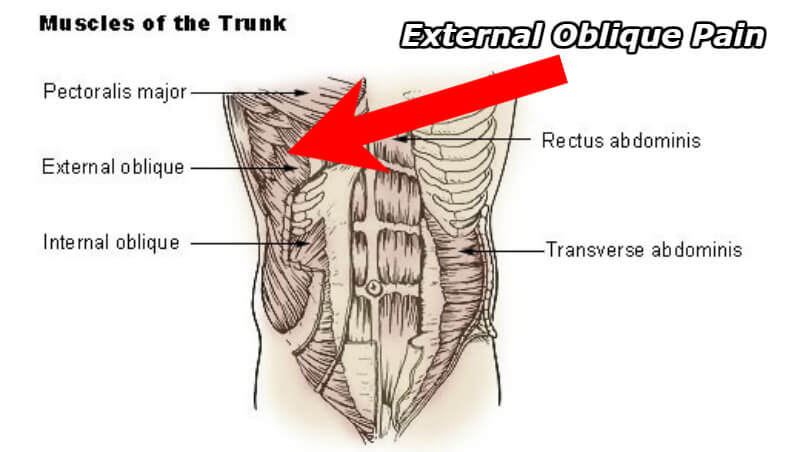
Experiencing any amount of external oblique pain can lead to panic, especially when you don’t know if the injury is a strain or a much more serious hernia. The muscle wraps around your lower ribs and its action is to provide support for your torso. It is also an important muscle in intra-abdominal pressure and proper pelvic function, which will become important as we explain in just a moment.
External Abdominal Oblique Strain Symptoms
Because it is such a large muscle and plays an important role in the stability and connectivity of the upper and lower body, it can produce a range of different issues and symptoms.
- Pain along the upper back just below the shoulder blades
- Pain in the lower back
- Pain in the lower abdomen and groin area
- Pain in the waist on either side of the body
- Pain in the pelvis, especially with increased movement
- In males, testicular pain is also possible
Mentioned above, the oblique muscles are responsible for connecting the ribs, hip, and lower spine. In layman’s terms it can be thought of as the waist muscle.
However, when it becomes tight and inhibited either from poor posture or repetitive activities such as lifting weights or slouching at an office desk for extended periods of time it can set the stage for serious injury.
This muscular imbalance then forces the hip to compensate and adapt weird movement patters—doing further damage and causing more issues. At a certain breaking point, enough is enough and the oblique muscle is the one that gives under too much stress and pressure. This can result in a damaging strain to the area.
Oblique Strain or Hernia?
It can also lead to an actual tear of the abdominal wall, resulting in a hernia. However, in the case of the external oblique muscle specifically, if that does happen it will almost always be accompanied with sharp or unending groin pain and classified a sports hernia—there will be no visible bulge.
In a case report published in the British Journal of Surgery, researchers found that the cause of chronic pain in athletes was actually being caused by nerves getting trapped and pinched in damaged and overly-tight external oblique muscles.
Symptoms of a More Serious Sports Hernia: Test Yourself
If you have a sports hernia, you will also experience significant pain in your lower abdomen and groin. The pain seems to go away with heavy rest, but comes back as soon as you attempt to return to activity.
For whatever reason, external oblique pain on the right side is more common in this case as well, though pain on the left isn’t completely unheard of.
If these describe you at all, make sure to complete the simple at-home test just to diagnose yourself be safe. It only takes a few seconds and will give you some much-needed peace of mind.
Because the obliques are so large and cover such a wide surface area, they can’t rely on a normal tendon that connects bone to muscle. They require a special, sheet-like material called aponeurosis to attach to the different areas of the ribs, pelvis, and trunk.
Unfortunately, because this fibrous sheet is so thin, it is unable to receive large amounts of blood and nutrients—making it a prime location for injury.
Cure Your External Oblique Pain: Strain Treatment and Rehabilitation
Immediately following injury or feeling pain, you should begin the RICE physical therapy protocol. This will help to soothe inflammation and swelling to the area so that it can begin to heal.
Once the initial swelling and pain has worn off though, you will need to complete a full-core treatment and rehabilitation plan that focuses on releasing trigger points in the external obliques and strengthening the area so that proper mobility and balance can be regained.
As you begin to alleviate tightness and build strength in weak areas of your hip and abdomen, you will experience lasting pain relief as your body is able to return to its natural bio-mechanical positioning.
If you have a severe tear, the only likely way for a full recovery is surgical intervention so that the area can be sutured for proper healing to begin.
